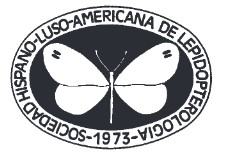Embryonic death as a probable reason for the collapse of population densities in Lymantria dispar (Linnaeus, 1758) (Lepidoptera: Erebidae, Lymantriinae)
DOI:
https://doi.org/10.57065/shilap.939Keywords:
Lepidoptera, Erebidae, Lymantriinae, Lymantria dispar, population dynamics, embryonic death, nucleopolyhedrovirusAbstract
For the first time the causes of mass death of embryos in a population of Lymantria dispar (Linnaeus, 1758) with biochemical and molecular methods are investigated. In this study egg masses were collected in the territory of Russia from two populations, with low (the West Siberian population) and high (Trans-Ural) density and analyzed. Spring hatching of larvae from the eggs stored under constant laboratory conditions at 2º C was two times lower for insects of the Trans-Ural (TU) population compared to the West Siberian (WS) population (43 ± 6 % and 86 ± 7 % accordingly). The level of virus defined by PCR for TU and WS populations was 76±9 % and 36±6%, respectively. The major components of eggs were the same between populations. However, we found decreased concentrations of proteins important for embryogenesis in TU population, such as an arilforin-like molecule and no vitellin 2-like component. Field data were comparable to those of the laboratory, and in TU populations there was a decrease of density. The obtained results suggest that alteration in hormonal balance of the infected with nucleopolyhedrovirus (NPV) insects may lead to a decrease or absence of some key proteins of embryogenesis in eggs. It can influence hatching of larvae from eggs and, accordingly, population dynamics of the lepidopteran.
Downloads
Global Statistics ℹ️
|
196
Views
|
123
Downloads
|
|
319
Total
|
|
References
BRADFORD, M., 1976.– A rapid and sensitive method for the quantitation of microgram quantities of protein utilizing the principle of protein-dye binding.– Analytical Biochemistry, 72: 248-254. DOI: https://doi.org/10.1006/abio.1976.9999
BURDEN, J. P., GRIFFITS, C. M., CORY, J. S., SMITH, P. & SAIT, S. M., 2002.– Vertical transmission of sublethal granulovirus infection in the Indian meal moth, Plodia interpunctella.– Molecular Ecology, 11: 547-555. DOI: https://doi.org/10.1046/j.0962-1083.2001.01439.x
CABODEVILLA, O., VILLAR, E., VITRO, C., MURILLO, R., WILLIAMS, T. & CABALLERO, P., 2011.– Intraand intergenerational persistence of an insect nucleopolyhedrovirus: adverse effects of sublethal disease on host development, reproduction, and susceptibility to superinfection.– Applied and Environmental Microbiology, 77: 2954-2960. DOI: https://doi.org/10.1128/AEM.02762-10
CHABROL, E. & CHARONNAT, R., 1937.– Une nouvelle reaction pour l’étude des lipids. L’eleidemie.– La presse médicale, 45: 1713-1714.
CORY, J. S. & MYERS, J. H., 2003.– The ecology and evolution of insect baculoviruses.– Annual Review of Ecology Evolution and Systematics, 34: 239-272. DOI: https://doi.org/10.1146/annurev.ecolsys.34.011802.132402
DWYER, G. & ELKINTON, J. S., 1995.– Host dispersal and the spatial spread of insect pathogens.– Ecology, 76: 1262-1275. DOI: https://doi.org/10.2307/1940933
EGOROV, N. N., 1958.– Pest insects of pine forests of West Siberia.– Zoologicheskiy zhurnal, 37: 1488-1499 [in Russian with English summary].
ELKINTON, J. S., 1990.– Population dynamics of gypsy moth in North America.– Annual Review of Entomology, 35: 517-596 DOI: https://doi.org/10.1146/annurev.ento.35.1.571
FULLER, E., ELDERD, B. D. & DWYER, G., 2012.– Pathogen Persistence in the Environment and Insect- Baculovirus Interactions: Disease-Density Thresholds, Epidemic Burnout and Insect Outbreaks.– American Naturalist, 179: 70-96. DOI: https://doi.org/10.1086/664488
GIESE, R. L. & SCHNEIDER, M. L., 1979.– Cartographic comparisons of Eurasian gypsy moth distribution (Lymantria dispar L., Lepidoptera: Lymantriidae).– Entomological News, 90: 1-16.
HAMILTON, A. G., 1950.– Further studies on the relation of humidity and temperature to the development of two species of African locusts - Locusta migratoria migratorioidaes (R. & F.) and Schistocerca gregaria (Forsk.).– Transactions of the Royal Entomological Society of London, 101: 1-58. DOI: https://doi.org/10.1111/j.1365-2311.1950.tb00374.x
HANSEN, J. & MøLLER, I., 1975.– Percolation of starch and soluble carbohydrates from plant tissue for quantitative determination with anthrone.– Analytical Biochemistry, 68: 87-94. DOI: https://doi.org/10.1016/0003-2697(75)90682-X
HOCH, G., ZUBRIC, M., NOVOTNY, J. & SCHOPF, A., 2001.– The natural enemy complex of the gypsy moth, Lymantria dispar (Lepidoptera, Lymantriidae) in different phases of its population dynamics in eastern Austria and Slovakia, a comparative study.– Journal of Applied Entomology, 125: 217-227. DOI: https://doi.org/10.1046/j.1439-0418.2001.00540.x
ILYINSKY, A. I. & TROPIN, I. V. (eds.), 1965.– Supervision, registration and prognosis of outbreaks of needle-and leaf-eating insects in forests of the USSR. Moscow: Lesnaya Promishlennost’ [in Russian].
ILYINYKH, A. V., 2002.– Analysis of causes of waning of mass reproduction of gypsy moth (Lymantria dispar L.) in the territory of the Novosibirsk region.– Contemporary problems of ecology, 6: 697-702.
ILYINYKH, A. V., 1997.– The method for the laboratory cultivation of Ocneria dispar L.– Biotechnologiya, 9-10: 27-29. [in Russian with English summary].
ILYINYKH, A. V. & POLENOGOVA, O. V., 2013.– Demonstration of remote effect for vertical transmission of baculovirus based on example of gypsy moth, Lymantria dispar L. (Lepidoptera, Lymantriidae).– Biology Bulletin Reviews, 3: 214-218. DOI: https://doi.org/10.1134/S2079086413030055
ILYINYKH, A. V., SHTERNSHIS, M. V. & KUZMINOV, S. V., 2004.– Exploration into a mechanism of transgenerational transmission of nucleopolyhedrovirus in Lymantria dispar L. in Western Siberia.– BioControl, 49: 441-454. DOI: https://doi.org/10.1023/B:BICO.0000034592.30160.50
INCEOGLU, A. B., KAMITA, S. G. & HAMMOCK, B. D., 2006.– Genetically modified baculoviruses: a historical overview and future outlook.– Advances in Virus Research, 68: 323-360. DOI: https://doi.org/10.1016/S0065-3527(06)68009-3
IZUMI, S., YANO, K., YAMAMOTO, Y. & TAKAHSHI, S. Y., 1994.– Yolk proteins from insect eggs: Structure, biosynthesis and programmed degradation during embryogenesis.– Journal of Insect Physiology, 40: 735-746. DOI: https://doi.org/10.1016/0022-1910(94)90001-9
JOHNSON, D. M., LIEBHOLD, A. M., BJØRNSTAD, O. N. & MCMANUS, M. L., 2005.– Circumpolar variation in periodicity and synchrony among gypsy moth populations.– Journal of Animal Ecology, 74: 882-892. DOI: https://doi.org/10.1111/j.1365-2656.2005.00980.x
KOLTUNOV, E. V., PONOMAREV, V. I. & FEDORENKO, S. I., 1998.– The gypsy moth Lymantria dispar ecology in conditions of anthropogenic influences. Ekaterinburg: UB RAS [in Russian with English summary].
KONDAKOV, Yu. P., 1963.– The gypsy moth (Ocneria dispar L.) in Krasnoyarsk region forests.– In Protection of Siberian forests from pest insects: 30-77. Lesnaya Promishlennost’, Moscow. [in Russian].
KOUASSI, L. N’G., TSUDO, K, GOTO, C., MUKARAVA, S., SAKAMAKI, S., KUSIGEMATI, K. & NAKAMURA, M., 2009.– Prevalence of latent virus in Spodoptera litura (Fabricius) (Lepidoptera: Noctuidae) and its activation by geterologous virus.– Applied Entomology and Zoology, 44: 95-102. DOI: https://doi.org/10.1303/aez.2009.95
KUKAN, B., 1999.– Vertical transmission of nucleopolyhedrovirus in insects.– Journal of Invertebrate Pathology, 74: 103-111. DOI: https://doi.org/10.1006/jipa.1999.4873
MURILLO, R., HUSSEY, M. S. & POSSEE, R. D., 2011.– Evidence for covert baculovirus infections in a Spodoptera exigua laboratory culture.– Journal of General Virology, 92: 1061-1070. DOI: https://doi.org/10.1099/vir.0.028027-0
MYERS, J., MALAKAR, H. R. & CORY, J. S., 2000.– Sublethal nucleopolyhedrovirus infection effects on female pupal weight, egg mass size, and vertical transmission in gypsy moth (Lepidoptera: Lymantriidae).– Environmental Entomology, 29: 1268-1272. DOI: https://doi.org/10.1603/0046-225X-29.6.1268
O’REILY, D. R. & MILLER, L. K., 1989. - A baculovirus blocks insect molting by producing ecydysteroid UDPglucosyl transferase.– Science, 245: 1110-1112. DOI: https://doi.org/10.1126/science.2505387
QUICKENDEN, K. L., 1970.– Carbohydrates in eggs of the grasshopper, Aulocara elliotti, during development.– Journal of Insect Physiology, 16: 171-183. DOI: https://doi.org/10.1016/0022-1910(70)90124-1
ROHRMANN, G. R., 2008.– Baculovirus molecular biology. Available from http://www.ncbi.nlm.nih.gov/books/NBK1736/.
SANDER, K., GUTZEIT, H. O. & JACKIE, H., 1985.– Insect Embryogenesis: Morphology, Physiology, Genetical and Molecular Aspects.– Comprehensive insect physiology, biochemistry and pharmacology, 1: 319-385.
SLAVICEK, J. M., POPHAM, H. J. R. & RIEGEL, C. I., 1999.– Deletion of the Lymantria dispar multicapsid nucleopolyhedrovirus ecdysteroid UDP-glucosyltransferase gene enhances viral killing speed in the last instar of the gypsy moth.– Biological Control, 16: 91-103. DOI: https://doi.org/10.1006/bcon.1999.0734
VILAPLANA, L., REDMAN, E. M., WILSON, K. & CORY, J. S., 2008.– Density- related variation in vertical transmission of a virus in the African armyworm.– Oecologia, 155: 237-246. DOI: https://doi.org/10.1007/s00442-007-0914-9
ZHOU, M., SUN, X., SUN, X., VLAK, J. M., HU, Z. & VAN DER WERF, W., 2005.– Horizontal and vertical transmission of wild-type and recombinant Helicoverpa armigera single-nucleocapsid nucleopolyhedrovirus.– Journal of Invertebrate Pathology, 89: 165-175. DOI: https://doi.org/10.1016/j.jip.2005.03.005
Published
How to Cite
Issue
Section
License

This work is licensed under a Creative Commons Attribution 4.0 International License.
The author SS retains his trademark and patent rights to any process or procedure within the article.
The author retains the right to share, distribute, perform and publicly communicate the article published in SHILAP Revista de lepidopterología, with initial acknowledgement of its publication in SHILAP Revista de lepidopterología.
The author retains the right to make a subsequent publication of his work, from using the article to publishing it in a book, provided that he indicates its initial publication in SHILAP Revista de lepidopterología.
Each submission to SHILAP Revista de lepidopterología must be accompanied by an acceptance of copyright and acknowledgement of authorship. By accepting them, authors retain copyright of their work and agree that the article, if accepted for publication by SHILAP Revista de lepidopterología, will be licensed for use and distribution under a "Creative Commons Attribution 4.0 International" (CC BY 4.0) licence that allows third parties to share and adapt the content for any purpose giving appropriate credit to the original work.
You may read here the basic information and the legal text of the license. The indication of the CC BY 4.0 License must be expressly stated in this way when necessary.
As of 2022, the content of the print and digital version is licensed under a "Creative Commons Attribution 4.0 International License" (CC BY 4.0), licence that allows third parties to share and adapt the content for any purpose giving appropriate credit to the original work.
Previous content in the journal was published under a traditional copyright licence; however, the archive is available for free access.
When using the contents of SHILAP Revista de lepidopterología published before 2022, including figures, tables or any other material in printed or electronic format belong to the authors of the articles, the authors must obtain the permission of the copyright holder. Legal, financial and criminal liabilities in this respect belong to the author(s).
In application of the Principle of Priority of the International Code of Zoological Nomenclature, no other version than the one published by the publisher may be deposited in repositories, personal websites or similar.





























